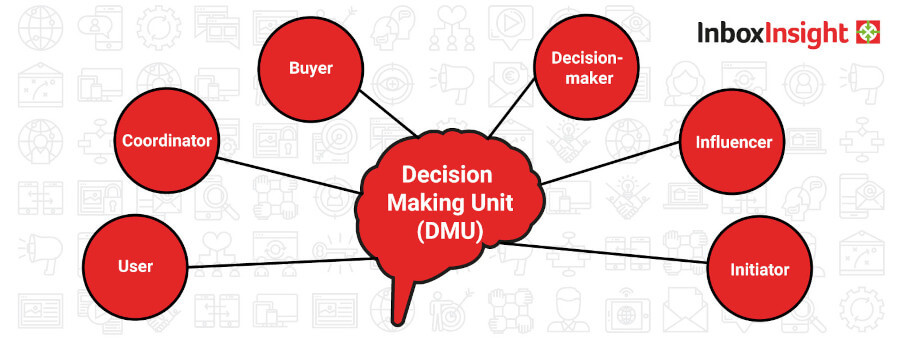As nearly 70% of companies involve 5 or more people in every B2B buying decision, understanding how to effectively target each individual will never be straightforward. What’s more, 90% of business professionals believe there is usually or always one member of the decision-making unit (DMU) who will try to influence the decision to match their own opinion.
Building strong engagement with a prospect is key, but has the purchase process ever unexpectedly stalled? Could this perhaps be down to the influence of others in the DMU?
Reading time: 5minutes
What is an ideal customer profile? And how does it help?
An ideal customer profile is a detailed description of a customer segment that includes demographic, psychographic, and behavioral characteristics. This profile helps to better understand your customers and enables you to target your products/services more effectively. It can be used to identify potential customers, assess their needs, and develop strategies to attract them.
Marketers create an ICP in order to understand the needs and wants of their target audience, allowing them to create marketing campaigns that are more likely to deliver a higher ROI. This can also help increase customer satisfaction and loyalty, as well as boost sales and profits. Moreover, an ideal customer profile can be used to identify new opportunities and create strategies to capitalize on them.However, identifying your ICP is only part of the challenge. Once you’ve established you are targeting the right customers, you then need to widen your scope to incorporate the whole decision-making unit.
What does the B2B decision-making unit look like?
The B2B decision-making unit is typically composed of members from different departments, such as marketing, finance, operations, and sales. Each member will bring their own unique perspective to the table and the team will work together to identify the best decision-making model to use to reach a decision. They’ll consider various factors, such as the company’s objectives, the current market situation, and the company’s resources.By considering all of these factors, the team is able to come up with a comprehensive plan that is tailored to the company’s specific needs. Because of this, your marketing and sales teams need to think about the bigger picture and how each member of the DMU is impacted by the content you deliver.

How do you win over the DMU? Answer these 10 questions.
Winning over the DMU is no easy feat. It requires a flexible approach that utilizes a number of different tactics. But most importantly, it requires a thorough understanding of exactly who you are targeting. By asking yourself the following 10 questions, you can uncover valuable intel to give you a significantly better chance of successfully winning them all over.
1. Who are they aiming to impress?
Retiring baby boomers are being replaced; 73% of millennials aged 20-35 are now involved in product or service purchase decisions for businesses. They possess different aspirations, values and beliefs, bringing their own fresh perspective to the workplace.
Are they looking to impress other members in the DMU? Their peers? Or maybe even their family? This new generation of B2B decision-makers is not preoccupied with just impressing those above. Understanding who they are seeking approval from is often the first step to discovering what is most important to them.
2. What struggles are they experiencing?
We asked our IFP IT community members about their key challenges and 37% of Heads of IT cited malware compared to only 12% of Directors. This is just one example of how every DMU member faces different pain points, be it professional or personal. Knowing what they are so that you can offer best-fit solutions is vital.
3. How can your content help make their jobs easier?
Once you know the individual pain points and daily struggles of your individual DMU members, you can design content that helps them overcome these challenges to make their day-to-day role easier.This can be anything from a how-to-guide that helps them better streamline their processes or on-demand webinars that troubleshoot common issues, to longer form whitepapers, analyst reports and trend forecasts.By providing the right content in the most accessible formats, you can help your target DMU member do their job more efficiently. This will help generate huge value and subsequently help build trust and brand loyalty.
4. Do they follow certain trends or topics?
58% of B2B marketers use intent data with the aim of identifying early buyer interest. Understanding user intent by analyzing intent data provides a good idea of what trends or topics individuals value the most. Likewise, knowing what they have chosen to subscribe to can give strong insights into their interests.
5. Are there patterns in the type of content they share on their LinkedIn feed?
Do they share carefully chosen, curated content? Or are they more inclined to post their own thought leadership on LinkedIn? Do they share a lot or a little?Understanding social media behavior can provide intel into interests, struggles and areas they are looking to explore. It can also indicate whether this channel will be a successful way of communicating with them – i.e. if they are an active and engaged user.
6. What knowledge will make them stand out in front of peers and other stakeholders?
B2B decision-makers want to look good in front of peers and stakeholders. Thought leadership, strategic input and trend forecasting are all strong methods to achieving this when done right. Focusing on valuable insights and knowledge required to meet their needs in these areas can get individuals on board for the resulting sense of gratification.
7. Who do they trust?
Identifying who each DMU member chooses to confide in, or who they turn to for advice, is a great way of gauging who they allow to have an influence on their decision-making.Do they turn to thought leaders? Industry analysts? Peer groups? Someone else?
8. Who do they aspire to be in the future?
Are you looking at a future CEO in the making? Might they aim to be a director? Or a thought leader?Once you know what they strive for, you’ll get a good indication of their agenda and career goals. This can reveal which shoes they’ll be looking to fill and who they’ll want to impress to get there. It will also help you understand how best to target them by knowing exactly where they want to be and how they’ll need to get there.
9. Which tone of voice (ToV) is most suitable?
When communicating to grasp someone’s attention, you need to know the ToV they are most responsive to. Does specialist terminology resonate best? Or accessible language? Do they prefer a warm, friendly tone or one which is more authoritative? Every individual communicates differently, so finding out their preferences can go a long way.
10. How can you make their decision-making process simpler?
Many B2B decision-makers want an easier life when given the difficult task of deciding what’s best for the business. Simplifying decision-making through a prescriptive approach or via a nurture process could help streamline the process and make it less complicated – win win.Again, considering content formats can also have an impact on the B2B decision-making process. Providing the right information in the most accessible way can remove some of the complexity, helping your B2B buyer fast-track through the evaluation process.
The key is to provide the right content
Failing to produce enough content to directly address the priorities of all key stakeholders in the B2B buying process could see your efforts wasted later down the line. Discover what appeals to each individual stakeholder and you can accurately plan your communications to deliver the best content experiences – resulting in a purchase.
Don’t let other DMU members sway the decision
Many individuals lead to one powerful and coercive buying collective. If you’ve built strong engagement with a prospect and seen them unexpectedly drop off, could this have been the influence of a senior decision-maker? Or someone else in the DMU?Make sure you appeal to ALL members of the DMU by answering the 10 key questions above for every influential stakeholder in the B2B purchase decision.






